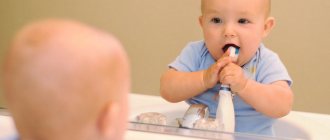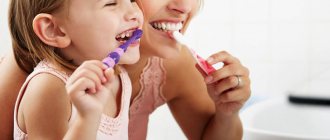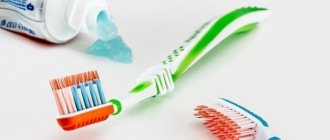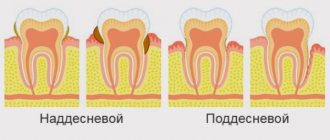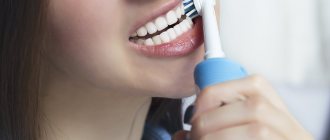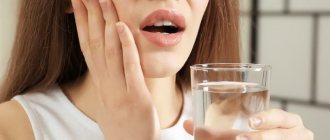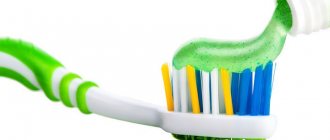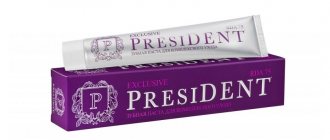20.11.2019
Not all parents know how to properly brush their children’s teeth, but the condition of the emerging permanent teeth depends on the quality of care for baby teeth. To protect your child from problems with molars, incisors and canines, it is necessary to teach him to brush and rinse his mouth after the very first tooth erupts.
Features of the structure of milk teeth
Baby teeth form in the sixth week of fetal development. Normally there are 20 of them:
- 8 molars;
- 8 incisors;
- 4 fangs.
Temporary teeth consist of the same tissues as permanent teeth:
- dentin (in temporary teeth it is softer and less mineralized);
- enamels;
- pulp.
However, primary incisors, canines and molars have features:
- low crowns;
- large distance between crowns;
- long thin roots that dissolve before the temporary tooth falls out and the permanent tooth erupts;
- thin enamel - only 1 mm;
- wide channels.
The structure of baby teeth is only slightly different from permanent teeth, so they no less need proper care. You can start brushing your child’s teeth after the very first incisor has erupted. Early training in hygiene will be an excellent prevention against many dental diseases that can affect the primary incisors, and then the rudiments of the permanent ones formed under them.
If you don’t care for your baby’s teeth or care for them incorrectly, your baby will have to visit pediatric dentists already in the first three years of life. Or he may tolerate drilling rotted teeth with a bur, which is painful and unpleasant for a small child, even with high-quality anesthesia.
Specific features of milk units
The structure of milk units is not very different from primary ones, so they also require regular hygiene. Parents often ask the question: at what age should a child brush his teeth? Pediatric dentists recommend practicing hygiene from the moment the first tooth appears. The sooner you teach your baby hygiene, the lower the risk of developing serious diseases. Milk units are also susceptible to the development of pathologies, so they need to be properly and competently cared for. It is very important that parents prevent the development of caries on baby teeth, otherwise they will have to undergo treatment in the dental office.
How to properly clean a baby's mouth
Immediately after being discharged from the hospital, you need to start wiping the newborn baby’s gums with a thick gauze swab dipped in water. You can also wet the tampon in:
- chamomile infusion, if the baby does not have constipation;
- bactericidal infusion of sage;
- St. John's wort decoction, as this plant strengthens the gums;
- anti-inflammatory decoction of calendula.
It is not recommended to use decoctions and infusions of herbs to treat the oral cavity of a baby more than 2-3 times a week, as their abuse can lead to allergic reactions.
Maintaining hygiene, which involves treating the oral mucosa with a gauze swab, is necessary for both newborns who are breastfed and those children who are fed artificial formula. Breast milk does not clean the oral cavity, but pollutes it. If you do not sanitize your baby’s mouth after feeding, then pathogenic bacteria will begin to multiply in it, which can lead to infection of the tooth enamel.
Oral care products
Before the appearance of the first incisors and molars, oral hygiene in newborns includes only wiping the gums and tongue. This way, parents can quickly remove harmful plaque and cleanse the child’s mouth of bacteria.
When the first tooth appears, it is recommended to clean it with a soft gauze swab or a special damp cloth. Even the softest brush will be unpleasant for a baby in such a delicate state.
ASEPTA BABY finger wipes from 0 to 3 years will help relieve unpleasant symptoms during teething. These amazingly pleasant massage tools will ensure gentle oral hygiene for the baby and massage the gums during teething.
- The corrugated surface of the napkins will give a light massage to the gums.
- Impregnation with plant extracts will prevent inflammation and help balance the acid-base balance of the oral cavity.
Wipes will help your baby form the habit of daily oral hygiene, providing daily pleasant procedures. ASEPTA BABY wipes will be especially convenient when traveling, because with them you can brush your teeth even in road conditions. Each napkin is individually packaged in a sealed bag, so their one-time use is 100% hygienic.
A bandage or gauze swab lightly moistened with boiled water is also suitable for wiping the first teeth of babies. Under no circumstances should you use cotton wool for daily oral hygiene in infants - this material is not suitable for their texture. Rough cotton wool will leave fibers behind, which can cause even more inflammation of the gums.
Brushing teeth after six months
In infants older than six months, the ejection reflex disappears. From this age, parents can use other means to clean their baby’s delicate teeth.
Finger toothbrush
A silicone brush will be a salvation for parents of infants. At an early age, the baby is not yet able to hold a toothbrush on his own and make the necessary movements with it, so you can brush your teeth with the help of a special fingertip.
Classic brush
A children's toothbrush is, first of all, a tool with very soft bristles. It is better that the children's brush has short and soft bristles, as well as a short and comfortable handle with which you can brush children's teeth. The first brush can be used from 1 year.
Toothpaste
Children should never brush their teeth with adult toothpaste. This hygiene product should also be selected according to the baby’s age.
For infants who are not yet receiving complementary foods, a gel-like paste with a neutral or milky taste is suitable. It is important that the product does not contain various abrasive substances, and that its taste evokes exclusively positive emotions in the baby.
An excellent means for cleaning teeth will be the children's gel paste from 0 to 3 years old ASEPTA BABY, designed for gentle care of the gums and baby teeth of babies. Children like its pleasant “tutti-frutti” taste, which makes brushing their teeth a joyful procedure and helps form a healthy habit of daily oral hygiene.
- The complex composition allows you to simultaneously care for your gums and teeth.
- The gel base provides gentle cleansing of teeth and gums.
- The paste is safe to swallow, as it does not contain components that can harm the baby's health.
ASEPTA BABY paste does not contain fluoride, therefore it does not require consultation with a doctor before use.
At what age should a child start brushing his teeth?
You need to start brushing your baby's teeth from the moment they begin to erupt. At first, it is better to perform manipulations without paste, carefully treating not only the first tooth, but also the gum itself. You can use a special soft baby brush or a silicone pad that is placed on the parent’s finger. The last device will serve not only as a brush, but also as a gum massager, which will relieve pain from teething.
You should act carefully during the cleaning process, since the gums near the cutting tooth are inflamed and painful, so infants may react poorly to the hygiene procedure. But you cannot refuse it: during teething, local immunity deteriorates, so the risk of infection of the enamel increases.
Second year of life
The child grows very quickly and by the age of one year he can firmly hold a toothbrush in his hands. Of course, adults will have to manage with inept hands. Rinsing a baby’s mouth is also an impossible task, so it is necessary to use a fluoride-free toothpaste.
At this age, the main criterion for choosing a brush is its safety. What to pay attention to:
- stiffness of the bristles;
- handle with anti-swallowing, non-slip handle;
- size of the working part (head).
For a little person, choose a hygiene attribute with soft but elastic bristles. Hard hairs can scratch fragile enamel and injure the gums. Preference is given to models with the same bristle height (approximately 10 mm), in 3-4 rows.
The size of the working surface should not exceed 20 mm (approximately the size of two teeth). The rounded head will prevent injury to the gums.
Bright handles with cartoon characters attract children's eyes. It is inconvenient to use an accessory with a massive handle at such a young age. To prevent the brush from slipping, manufacturers provide a rubberized or ribbed coating.
A protective ring must be required.
How to properly brush children's teeth
There are several general rules for high-quality teeth cleaning, depending on the age of the baby:
- A child under one year old should brush his teeth using a special silicone pad, which is fixed on the parent’s index or thumb.
- After a year, you can use a brush with silicone bristles and a special limiter, gradually switching to classic models.
- From the age of three, a regular brush with soft bristles is used. It is important that its surface is covered only by two dental crowns, otherwise the hygienic procedure will not be effective enough.
A baby brush needs to be changed every 3-4 months. If the service life has not yet expired, but the brush has already become rough around the edges, you should change it, since pathogenic bacteria can begin to form and multiply between the bristles.
How to brush the teeth of a child under 1 year old
Six months is the age when parents should start brushing their child’s teeth every day. From 6 to 12 months, children are cutting teeth, so during this period it is necessary to sanitize their oral cavity very carefully. The baby cannot yet take part in the hygiene procedure, but can already express his dissatisfaction with sounds and gestures, so the adult should focus not only on the dental cleaning technique, but also on the baby’s sensations.
How to properly brush your first teeth
Key cleaning rules:
- the necessary movements should be sweeping: from the root to the top;
- the finger with the silicone attachment should be in the child’s mouth at an angle of 45 degrees to the gums;
- when processing chewing surfaces, the finger with the nozzle is positioned horizontally and cleans the crown with progressive longitudinal movements;
- The inner surface of the teeth is cleaned with short, quick movements;
- The side teeth can be cleaned using circular movements.
There should be about 10–15 movements per tooth. During the procedure, it is necessary to clean not only the dental enamel, but also the inner surface of the cheeks, tongue and gums. You can also brush your one-year-old child's teeth using special dental wipes, which can be purchased at the pharmacy.
Why you need to teach your child to brush their teeth earlier than one year
You should start brushing your baby's baby teeth when the first incisor appears or even before it fully erupts. Complete oral care will help:
- form the correct bite;
- It is good to clean the oral cavity from cariogenic bacteria;
- prevent various diseases, including caries.
How to brush teeth for children over one year old
A child over 1 year old can purchase their first toothbrush with silicone bristles. It costs more than a regular one, but such a waste of money is justified: a brush with silicone bristles will not injure the child’s teeth and will help to thoroughly clean the gums and cheeks. You can use it to clean even your child’s first teeth. However, such brushes quickly become unsuitable for safe use, so they should not be used for a long time.
Rules for caring for a children's toothbrush with silicone bristles
In order for the silicone brush to last longer, you must follow the following rules for its operation:
- Do not boil or even simply pour boiling water over the brush;
- After each use, you should wash it with soap (baby, tar, laundry).
The brush should not be placed in a case; it should be stored in a closed cabinet, in a glass, separately from the brushes of adult family members.
When should you start taking care of your teeth?
Most dentists agree that the start of brushing a baby's teeth should coincide with their appearance. Most often, the first tooth erupts in babies' mouths at six months. However, in some children, the first incisors appear earlier, and some delight their parents with their first tooth only at one year of age.
An erupted tooth is a tooth whose tip has already emerged from the gums. Caring for the baby's first incisors should be carried out as carefully as possible - often a real wound forms around the cutting pearl and cleaning can be very painful for the baby. In addition, we should not forget that during teething, the baby’s local immunity decreases and the risk of contracting an infection increases.
Some dentists are convinced that oral care for infants should begin before teeth appear. The fact is that even in the absence of incisors and molars, and even in the absence of complementary foods in the diet, microorganisms accumulate on the baby’s oral mucosa. These bacteria can cause unpleasant diseases such as stomatitis, gingivitis or candidiasis.
In addition, such early care of your baby’s gums will help him form a habit of hygiene. And at the age of 5-6 months, when the baby begins to distinguish between “his own and someone else’s,” a toothbrush and special pastes will no longer cause him to panic and protest. According to dentists, infants should start brushing their teeth at the age of 3-4 months.
Toothpastes for one-year-old children and infants
To start brushing children's teeth using toothpaste, it is not necessary to wait until the child is one or three years old. Most toothpastes are indicated for children over 2 years of age, however, there are a number of manufacturers whose product lines include good fluoride-free toothpastes suitable for children under one year of age. They are completely harmless and can be swallowed. Such products can be found among the brands:
- ROCS
- Elmex.
- Splat.
- Lacalut.
Each toothpaste indicates at what age it is approved for use - you need to brush your child’s teeth only with a product that is not contraindicated for him and is suitable for comprehensive care of children’s teeth.
When starting to brush the teeth of a child under one year old using toothpaste, you need to monitor his reaction. Some babies may develop allergies, so at the first symptoms of a rash or an incomprehensible cough, you should stop using the paste and show your baby to a doctor.
First year of life
When you hear the ringing sound of a spoon touching the first incisor, do not rush to run for a brush.
For infants up to one year old, there are their own care products:
- silicone fingertip;
- sterile bandage;
- dental wipes.
The advantages of the listed means are that they are worn on the finger. This allows you to feel the gums and adjust the pressure.
The most inexpensive way is to use a bandage or gauze soaked in water or soda solution. A small amount of bandage is moistened, wrung out and wrapped around the finger. The gums, tongue and inner surface of the cheeks are treated.
Purchasing dental wipes will hit your pocket much more. They are intended for one-time use, treated with a special antiseptic solution that is safe for the baby. Neutral in taste, will not leave any unpleasant sensations in the baby.
Children's stores have a huge selection of silicone fingertips. For the first manipulations, it is better to choose a smooth attribute.
For older babies, you can offer finger pads with silicone bristles. They are more reminiscent of a toothbrush and massage the gums better. After each use, wash in running water. Boil before first use.
Teeth brushing technique with toothpaste
You can start brushing your teeth with toothpaste when the child’s first incisor appears, the deadline is one and a half years. You shouldn’t wait until he develops caries due to lack of proper care.
Brushing procedure with toothpaste:
- a certain amount of paste is applied to a pre-moistened brush;
- the brush is brought at a right angle to the crowns;
- The tooth surface must be cleaned using sweeping movements: from the roots to the tops;
- The inner dental surface is cleaned with short movements, the brush is placed at an angle of 45 degrees;
- the cutting and chewing surfaces of the crowns are processed at the very end;
- after completing the procedure, you should rinse your mouth with water;
- The approximate duration of each cleaning is 2–3 minutes.
3 years old is the age when you need to start teaching your child to brush their teeth on their own.
Rinse aids for little ones
Manufacturers of mouthwashes do not recommend the use of such products for children under six years of age, as there is a high risk that the baby will swallow the mouthwash.
Cleaning Rules
As the baby grows, hygiene attributes also change. Choosing them is not an easy task.
But even the safest brush can cause harm if you do not follow simple rules:
- The chewing surface is cleaned with circular movements, and the front part - only with vertical movements.
- The tongue also needs cleaning.
- Wash the brush thoroughly and do not forget to replace it with a new one regularly (once every 3 months).
- Dentists recommend brushing your teeth twice a day.
- The duration of the procedure should not exceed three minutes.
How to teach a child to brush their teeth
Many children under 1 year old, and sometimes older children, do not want to brush their teeth, expressing their dissatisfaction in every possible way. In this case, it is necessary to attract their attention to the hygiene procedure using one of the following methods:
- buy a bright brush with your favorite cartoon character and toothpaste with a pleasant fruity taste;
- invite your child to brush the teeth of his toys;
- brush your teeth with your child and compete with him in the quality and speed of brushing.
Each parent independently decides at what age to start brushing their child’s teeth and whether to use toothpaste, but delay can negatively affect the baby’s health. Parents should not only brush their children’s teeth, but also teach them how to properly care for their mouth on their own.
Category Children Published by Mister stomatolog
What is xylitol and why is it important?
Baby children's teeth are more vulnerable and susceptible to caries than molars. Together with candy, sweet foods and carbonated drinks, bacteria that cause tooth decay receive sugar, a substance necessary for their growth and development. Bacteria convert sugar into acid, and it eats away the enamel, causing microcracks to appear in it. Through them, bacteria get inside - this is how caries begins.
Xylitol or xylitol is a natural white crystalline substance with a sweet taste that is found in the fibers of fruits, vegetables, birch bark and even mushrooms and is not a breeding ground for bacteria. When xylitol is added instead of sugar, it stops the growth and development of caries.
Additionally, consuming xylitol instead of sugar:
- Improves the condition of the gums - bacterial plaque does not have time to accumulate, reducing the likelihood of tissue inflammation.
- Accelerates the process of enamel remineralization, thereby reducing existing caries and slowing down the development of new ones.
Xylitol is used not only as a sweetener, but is also added to oral care products. Products containing xylitol can be consumed at any age. For children, 2-3 pieces of 100% xylitol chewing gum per day are enough to significantly reduce the risk of plaque and tooth decay.
Here are some products with xylitol that kids will love.
Lollipop Miradent XyliPOP (blueberry), 5 pcs.
Lollipops miradent Xylitol Drops mint
Chewing gum Miradent Xylitol For Kids strawberry
